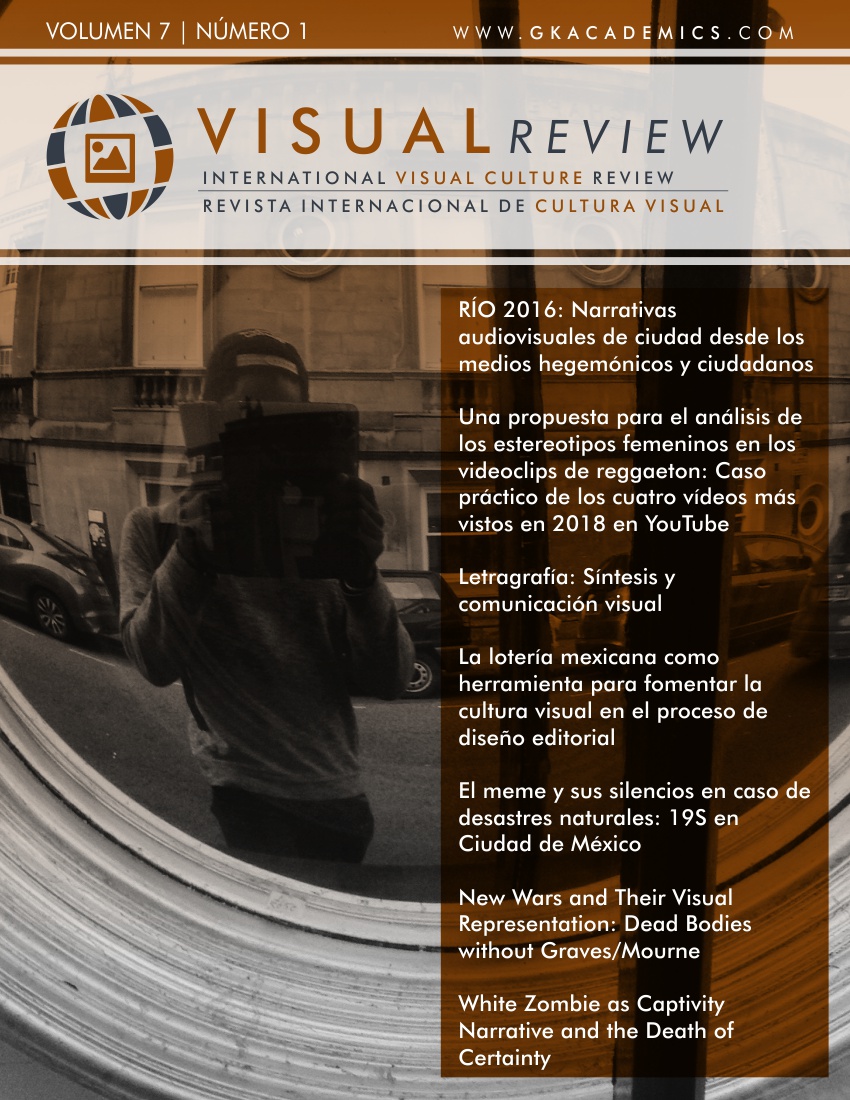White Zombie as Captivity Narrative and the Death of Certainty
DOI:
https://doi.org/10.37467/gka-revvisual.v7.2604Palabras clave:
Zombies, Western, Manifest Destiny, American imperialismResumen
Horror films such as White Zombie (1932) reveal viewers to themselves by narrating in the currency of audience anxiety. Such movies evoke fright because they recapitulate fear and trauma that audiences have already internalized or continue to experience, even if they are not aware of it. White Zombie’s particular tack conjures up an updated captivity narrative wherein a virginal white damsel is abducted by a savage other.
The shell of the captivity story is as old as America and relates closely to the Western and to the frontier myth, from which the Western emerged. What inexorably links the Western and all zombie films is the notion of containment. Whereas the Western sought to contain the American Other, all zombie films ask, instead, what happens if the other breaks through the proverbial gates. In other words, what if containment fails?
Descargas
Estadísticas globales ℹ️
|
683
Visualizaciones
|
671
Descargas
|
|
1354
Total
|
|
Citas
Berkenstein, Jeff, Anna Froula, & Karen Randell (eds.) (2010): Reframing 9/11. Film, Popular Culture and the “War on Terror.” New York: Continuum.
Bouchard, Gerard. (2017). Social Myths and Collective Imaginaries. Toronto: University of Toronto Press.
Briefel, Aviva & Sam J. Miller (eds.) (2011). Horror After 9/11. Austin: University of Texas Press.
Castiglia, Cristopher. (1996). Bound and Determined: Captivity, Culture-Crossing, and White Womanhood from Mary Rowlandson to Patty Hearst. Chicago: University of Chicago Press.
Cobb, William C. (1998). The American Foundation Myth in Vietnam: Reigning Paradigms and Raining Bombs. Lanham, MD: University Press of America.
Comaroff, Jean & John L. Comaroff. (2002). Alien-Nation: Zombies, Immigrants, and Millennial Capitalism. The South Atlantic Quarterly 101 (4) 779-805.
Cox, Damian & Michael Levine. (2016). ‘I am not living next door to no zombie’: Posthumans and Prejudice.Critical Philosophy of Race 4 (1), 74-94.
Drezner, Daniel W. (2011). Theories of International Politics and Zombies. Princeton: Princeton University Press.
Entman, Robert M. & Andrew Rojecki. (2001). The Black Image in the White Mind. Chicago: University of Chicago Press.
Grandin, Greg. (2007). Empire's Workshop. Latin America, the United States, and the Rise of the New Imperialism. New York: Holt.
Limerick Patricia, Nelson, (1995). Turnerians All. The Dream of a Helpful History in an Intelligible World. The American Historical Review 100 (3), 697-716.
Luckhurst, Roger. (2015). Zombies, A Cultural History. London: Reaktion Books.
MacNeil, Denise. (August 15, 2006). “Mary Rowlandson and the Foundational Mythology of the American Frontier Hero.” Women’s Studies, 625-653.
McCain, John S. (2008). John McCain, Prisoner of War: A First-Person Account. US News and World Report, January 28, 2008.
McIntosh, Shawn & Marc Leverette (eds.) (2012). Zombie Culture, Autopsies of the Living Dead. Lanham, MD: Scarecrow Press.
Mitchell, Nancy. (2000). The Danger of Dream: German and American Imperialism in Latin America. Chapel Hill: University of North Carolina Press.
Rhodes Gary D. (2001). White Zombie, Anatomy of a Horror Film Jefferson. NC: McFarland.
Schmidt, Hans. (1995). The United States Occupation of Haiti, 1915-1934. New Brunswick, NJ: Rutgers University Press.
Schoultz, Lars. (1998). Beneath the United States: A History of U.S. Policy Toward Latin America. Cambridge: Harvard.
Seabrook, William. ([1929] 2016). The Magic Island. New York: Dover Books.
Slotkin, Richard. (1973). Regeneration Through Violence, The Mythology of the American Frontier, 1600-1860. Norman: University of Oklahoma Press.
Sutherland, Meghan. (Spring, 2007). Rigor/Mortis: The Industrial Life of Style in American Zombie Cinema. Framework 48 (1), 64-78.
Tirman, John. (2011). The Deaths of Others: The Fate of Civilians in America’s Wars. New York: Oxford University Press.
Wegener, Signe E. (2005): James Fenimore Cooper Versus the Cult of Domesticity. Progressive Themes of Femininity and Family in the Novels. Jefferson, NC: McFarland.
Wetmore, Kevin J. (2012). Post-9/11 Horror in American Cinema. New York: Continuum.
Williams, Tony. (1983). White Zombie, Haitian Horror. Jump Cut 28, 18-20.
Descargas
Publicado
Cómo citar
Número
Sección
Licencia
Los autores/as que publiquen en esta revista aceptan las siguientes condiciones:
- Los autores/as conservan los derechos de autor.
- Los autores/as ceden a la revista el derecho de la primera publicación. La revista también posee los derechos de edición.
- Todos los contenidos publicados se regulan mediante una Licencia Atribución/Reconocimiento-SinDerivados 4.0 Internacional. Acceda a la versión informativa y texto legal de la licencia. En virtud de ello, se permite a terceros utilizar lo publicado siempre que mencionen la autoría del trabajo y a la primera publicación en esta revista. Si transforma el material, no podrá distribuir el trabajo modificado.
- Los autores/as pueden realizar otros acuerdos contractuales independientes y adicionales para la distribución no exclusiva de la versión del artículo publicado en esta revista (p. ej., incluirlo en un repositorio institucional o publicarlo en un libro) siempre que indiquen claramente que el trabajo se publicó por primera vez en esta revista.
- Se permite y recomienda a los autores/as a publicar su trabajo en Internet (por ejemplo en páginas institucionales o personales), una vez publicado en la revista y citando a la misma ya que puede conducir a intercambios productivos y a una mayor y más rápida difusión del trabajo publicado (vea The Effect of Open Access).













